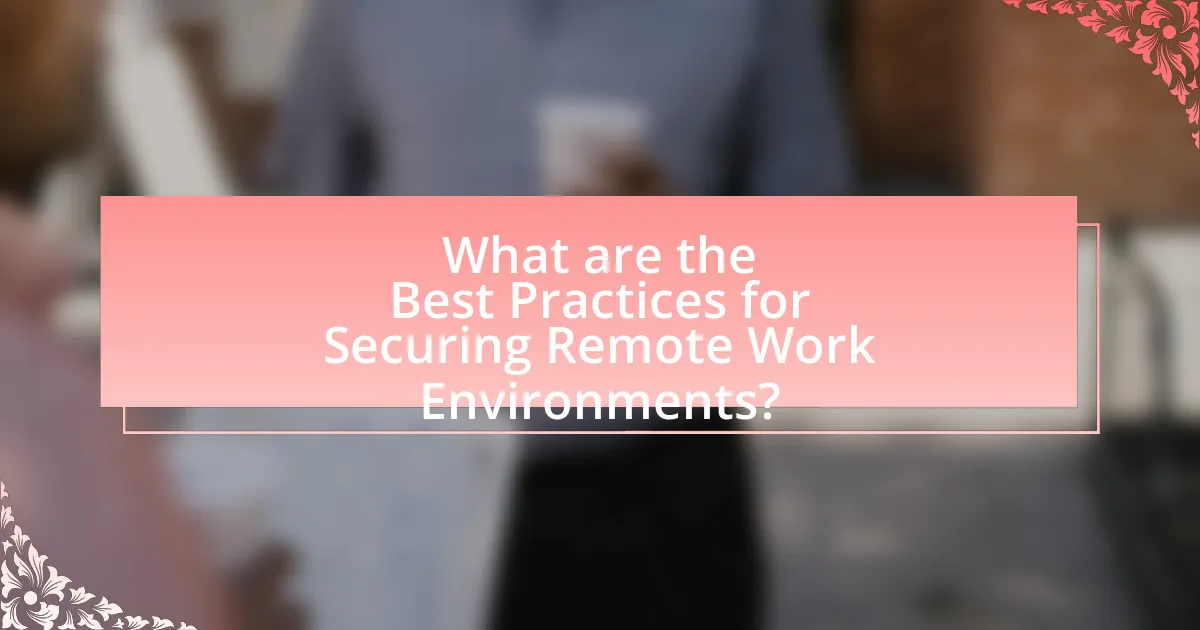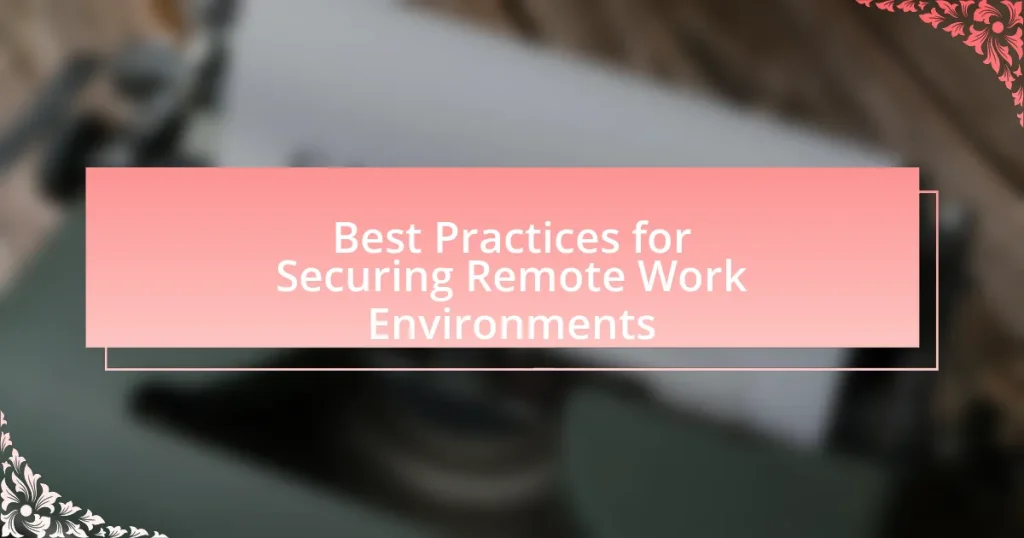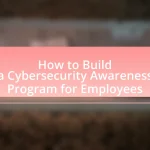The article focuses on best practices for securing remote work environments, emphasizing the importance of strong password policies, multi-factor authentication, regular software updates, and employee training on cybersecurity awareness. It outlines the essential components of a secure remote work setup, including secure network connections and data encryption, while addressing the risks associated with remote work, such as cybersecurity threats and decreased productivity. Additionally, the article discusses the implications of security breaches for organizations, the role of technology in enhancing security, and practical tips for implementing effective security measures to protect sensitive information in remote work settings.

What are the Best Practices for Securing Remote Work Environments?
The best practices for securing remote work environments include implementing strong password policies, utilizing multi-factor authentication, ensuring regular software updates, and providing employee training on cybersecurity awareness. Strong password policies reduce the risk of unauthorized access, while multi-factor authentication adds an additional layer of security, making it harder for attackers to gain entry. Regular software updates patch vulnerabilities that could be exploited by cybercriminals, and employee training equips staff with the knowledge to recognize phishing attempts and other threats. According to a report by Cybersecurity & Infrastructure Security Agency (CISA), organizations that adopt these practices significantly reduce their risk of data breaches and cyber incidents.
Why is securing remote work environments essential?
Securing remote work environments is essential to protect sensitive data and maintain organizational integrity. With the rise of remote work, cyber threats have increased significantly; for instance, a report by Cybersecurity Ventures predicts that global cybercrime costs will reach $10.5 trillion annually by 2025. This underscores the necessity for robust security measures to prevent data breaches, unauthorized access, and potential financial losses. Furthermore, securing these environments ensures compliance with regulations such as GDPR and HIPAA, which mandate the protection of personal and sensitive information. Thus, effective security protocols are critical for safeguarding both the organization and its employees.
What risks are associated with remote work?
The risks associated with remote work include cybersecurity threats, isolation, and decreased productivity. Cybersecurity threats arise from unsecured home networks and personal devices, making remote workers vulnerable to data breaches; for instance, a report by Cybersecurity Ventures predicts that cybercrime will cost the world $10.5 trillion annually by 2025. Isolation can lead to mental health issues, as remote workers may experience loneliness and disconnection from colleagues, which can negatively impact morale and collaboration. Additionally, decreased productivity can occur due to distractions at home, with studies indicating that remote workers may struggle to maintain focus compared to their in-office counterparts.
How do security breaches impact organizations?
Security breaches significantly impact organizations by compromising sensitive data, leading to financial losses, reputational damage, and legal consequences. For instance, the 2020 IBM Cost of a Data Breach Report indicated that the average cost of a data breach was $3.86 million, highlighting the financial burden on affected organizations. Additionally, breaches can erode customer trust; a 2021 survey by PwC found that 87% of consumers would take their business elsewhere if they felt their data was not secure. Legal ramifications also arise, as organizations may face lawsuits and regulatory fines, further exacerbating the financial and reputational toll.
What are the key components of a secure remote work environment?
The key components of a secure remote work environment include strong authentication methods, secure network connections, regular software updates, data encryption, and employee training on security best practices. Strong authentication methods, such as multi-factor authentication, significantly reduce unauthorized access risks, as evidenced by a 99.9% reduction in account compromise according to Microsoft. Secure network connections, like VPNs, protect data in transit, while regular software updates patch vulnerabilities that could be exploited by attackers. Data encryption ensures that sensitive information remains confidential, and employee training fosters awareness of phishing and other cyber threats, which is crucial since human error accounts for 95% of security breaches.
What role does VPN play in securing remote connections?
A VPN (Virtual Private Network) plays a crucial role in securing remote connections by encrypting internet traffic and masking the user’s IP address. This encryption protects sensitive data from interception by unauthorized parties, ensuring that information transmitted over public networks remains confidential. For instance, a study by the University of Maryland found that using a VPN can reduce the risk of data breaches by up to 70%, highlighting its effectiveness in safeguarding remote communications. Additionally, VPNs create a secure tunnel for data, which is essential for remote workers accessing corporate resources, thereby enhancing overall cybersecurity in remote work environments.
How can strong passwords enhance security?
Strong passwords enhance security by significantly reducing the risk of unauthorized access to accounts and sensitive information. A strong password typically includes a combination of uppercase and lowercase letters, numbers, and special characters, making it difficult for attackers to guess or crack through brute force methods. According to a study by the National Institute of Standards and Technology (NIST), using complex passwords can decrease the likelihood of successful cyberattacks, as they require exponentially more time and resources to break compared to simple passwords. Therefore, implementing strong passwords is a critical component of safeguarding remote work environments against potential security breaches.
What policies should organizations implement for remote work security?
Organizations should implement comprehensive remote work security policies that include data encryption, multi-factor authentication, and regular security training for employees. Data encryption protects sensitive information during transmission and storage, ensuring that unauthorized access is minimized. Multi-factor authentication adds an additional layer of security by requiring multiple forms of verification before granting access to systems. Regular security training equips employees with the knowledge to recognize phishing attempts and other cyber threats, significantly reducing the risk of security breaches. According to a report by Cybersecurity & Infrastructure Security Agency, organizations that adopt these measures can reduce the likelihood of successful cyberattacks by up to 80%.
How can organizations create effective remote work security policies?
Organizations can create effective remote work security policies by implementing a comprehensive framework that includes clear guidelines, regular training, and robust technology solutions. Establishing specific protocols for data access, usage, and sharing ensures that employees understand their responsibilities. Regular training sessions on cybersecurity best practices, such as recognizing phishing attempts and using strong passwords, enhance employee awareness and compliance. Additionally, utilizing technology such as Virtual Private Networks (VPNs), multi-factor authentication, and endpoint security solutions protects sensitive information from unauthorized access. According to a report by Cybersecurity & Infrastructure Security Agency (CISA), organizations that adopt a layered security approach significantly reduce the risk of data breaches.
What training is necessary for employees to follow security protocols?
Employees must undergo comprehensive cybersecurity training to effectively follow security protocols. This training should cover topics such as recognizing phishing attempts, understanding password management, and implementing multi-factor authentication. According to a report by the Ponemon Institute, organizations that provide regular security awareness training can reduce the risk of a data breach by up to 70%. Additionally, training should include practical exercises and simulations to reinforce learning and ensure employees can apply security measures in real-world scenarios.
How can technology aid in securing remote work environments?
Technology can aid in securing remote work environments by implementing robust cybersecurity measures such as virtual private networks (VPNs), multi-factor authentication (MFA), and endpoint security solutions. VPNs encrypt internet traffic, ensuring secure data transmission, while MFA adds an extra layer of security by requiring multiple forms of verification before granting access. Endpoint security solutions protect devices from malware and unauthorized access, which is crucial as remote workers often use personal devices that may lack adequate security. According to a report by Cybersecurity Ventures, global cybercrime damages are projected to reach $10.5 trillion annually by 2025, highlighting the necessity of these technological measures in safeguarding remote work environments.
What tools are available for monitoring remote work security?
Tools available for monitoring remote work security include Virtual Private Networks (VPNs), endpoint security software, and security information and event management (SIEM) systems. VPNs encrypt internet traffic, ensuring secure connections for remote workers. Endpoint security software protects devices from malware and unauthorized access, while SIEM systems aggregate and analyze security data from various sources to detect potential threats. These tools collectively enhance the security posture of remote work environments by providing real-time monitoring and threat detection capabilities.
How can multi-factor authentication improve security?
Multi-factor authentication (MFA) significantly improves security by requiring users to provide multiple forms of verification before gaining access to systems or data. This additional layer of security reduces the risk of unauthorized access, as it is much harder for attackers to compromise multiple authentication factors simultaneously. For instance, a study by the Cybersecurity & Infrastructure Security Agency (CISA) found that MFA can block over 99% of automated cyberattacks, demonstrating its effectiveness in protecting sensitive information in remote work environments.
What are common challenges in securing remote work environments?
Common challenges in securing remote work environments include inadequate security protocols, lack of employee training, and vulnerabilities in home networks. Inadequate security protocols often arise from organizations not implementing robust measures such as multi-factor authentication or encryption, which can lead to data breaches. A lack of employee training results in users being unaware of phishing attacks or safe internet practices, increasing the risk of security incidents. Additionally, vulnerabilities in home networks, such as weak passwords or outdated routers, can expose sensitive company data to cyber threats. According to a report by Cybersecurity & Infrastructure Security Agency, 90% of data breaches are caused by human error, highlighting the critical need for comprehensive training and security measures in remote work settings.
How do employees’ personal devices affect security?
Employees’ personal devices significantly affect security by introducing vulnerabilities that can be exploited by cyber threats. When employees use their own devices for work, they may lack the necessary security measures, such as updated antivirus software or secure configurations, which increases the risk of data breaches. According to a report by IBM, 95% of cybersecurity breaches are caused by human error, often linked to personal devices that are not adequately secured. This highlights the importance of implementing strict policies and security protocols for personal device usage in remote work environments to mitigate these risks.
What are the implications of using public Wi-Fi for remote work?
Using public Wi-Fi for remote work poses significant security risks, including data interception and unauthorized access to sensitive information. Public networks are often unsecured, making it easier for cybercriminals to employ techniques such as packet sniffing to capture data transmitted over the network. According to a study by the Federal Trade Commission, 70% of public Wi-Fi networks lack encryption, which heightens the risk of data breaches. Additionally, using public Wi-Fi can expose devices to malware and phishing attacks, as malicious actors can create rogue hotspots that mimic legitimate networks. Therefore, remote workers should avoid using public Wi-Fi for accessing sensitive information or utilize a Virtual Private Network (VPN) to encrypt their connection and enhance security.
What are the best practices for employees working remotely?
The best practices for employees working remotely include establishing a dedicated workspace, maintaining regular communication with team members, and utilizing secure technology. A dedicated workspace enhances focus and productivity, while regular communication fosters collaboration and team cohesion. Utilizing secure technology, such as VPNs and encrypted communication tools, protects sensitive information and reduces the risk of cyber threats. According to a study by Buffer in 2022, 98% of remote workers believe that having a designated workspace improves their productivity, highlighting the importance of these practices in securing remote work environments.
How can employees ensure their home networks are secure?
Employees can ensure their home networks are secure by implementing strong passwords, enabling network encryption, and regularly updating their router firmware. Strong passwords prevent unauthorized access, while encryption, such as WPA3, protects data transmitted over the network. Regular firmware updates address vulnerabilities, enhancing overall security. According to the Cybersecurity & Infrastructure Security Agency, using these measures significantly reduces the risk of cyber threats, making home networks safer for remote work.
What steps should employees take to recognize phishing attempts?
Employees should take the following steps to recognize phishing attempts: first, they should scrutinize email addresses and URLs for discrepancies, as phishing emails often use slight variations of legitimate addresses. Second, employees should be cautious of unsolicited messages that create a sense of urgency or require immediate action, which is a common tactic used by phishers. Third, they should verify the authenticity of requests for sensitive information by contacting the organization directly through official channels. Additionally, employees should look for poor grammar and spelling errors, which are often indicators of phishing attempts. According to the Anti-Phishing Working Group, 74% of phishing attacks are linked to email, highlighting the importance of vigilance in recognizing these threats.
What are the future trends in remote work security?
Future trends in remote work security include the increased adoption of zero-trust security models, enhanced endpoint security, and the integration of artificial intelligence for threat detection. Zero-trust models require continuous verification of user identities and device security, minimizing the risk of unauthorized access. According to a 2022 report by Cybersecurity Insiders, 76% of organizations are planning to implement zero-trust strategies in the coming years. Enhanced endpoint security focuses on securing devices used for remote work, as remote workers often access sensitive data from various locations. Additionally, AI-driven security solutions are expected to play a crucial role in identifying and responding to threats in real-time, with a projected market growth of 23.6% annually through 2027, as reported by MarketsandMarkets. These trends indicate a shift towards more proactive and adaptive security measures in remote work environments.
How is artificial intelligence shaping remote work security?
Artificial intelligence is significantly enhancing remote work security by automating threat detection and response. AI systems analyze vast amounts of data to identify unusual patterns and potential security breaches in real-time, which is crucial for protecting sensitive information in remote work settings. For instance, according to a report by McKinsey, organizations that implement AI-driven security measures can reduce the time to detect and respond to threats by up to 90%. This capability allows businesses to proactively address vulnerabilities, ensuring a safer remote work environment.
What emerging technologies can enhance remote work security?
Emerging technologies that can enhance remote work security include zero trust architecture, artificial intelligence for threat detection, and secure access service edge (SASE). Zero trust architecture operates on the principle of “never trust, always verify,” ensuring that every user and device is authenticated and authorized before accessing resources. According to a report by Forrester Research, organizations implementing zero trust can reduce the risk of data breaches by up to 50%.
Artificial intelligence enhances threat detection by analyzing patterns and identifying anomalies in real-time, which can significantly improve incident response times. A study by IBM found that organizations using AI for security can reduce the average time to identify a breach from 207 days to just 77 days.
Secure access service edge (SASE) combines network security functions with wide area networking capabilities to provide secure access to applications regardless of user location. Gartner predicts that by 2024, 40% of enterprises will adopt SASE as a primary means of securing remote work environments. These technologies collectively strengthen the security posture of remote work setups by addressing vulnerabilities and enhancing overall resilience against cyber threats.
What practical tips can organizations implement for securing remote work environments?
Organizations can implement several practical tips for securing remote work environments, including enforcing strong password policies, utilizing multi-factor authentication, and providing regular cybersecurity training. Strong password policies reduce the risk of unauthorized access, as studies show that 81% of data breaches are linked to weak passwords. Multi-factor authentication adds an additional layer of security, making it significantly harder for attackers to gain access even if passwords are compromised. Regular cybersecurity training ensures that employees are aware of potential threats, such as phishing attacks, and know how to respond appropriately, which is crucial since human error is a leading cause of security breaches.


